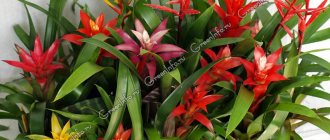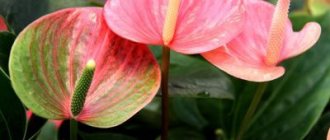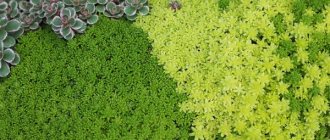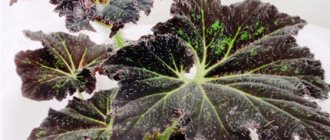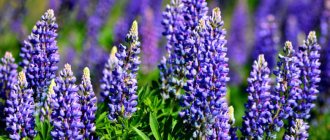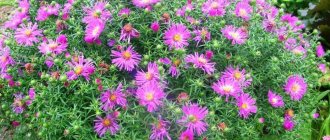Floral and ornamental plants that are widely used in the colorful landscaping of parks, gardens, alpine hills, rocky gardens and ponds also include perennial plants of the iris family. In their color qualities they are similar to the decorative growing family Carnationaceae, but have a wider range of applications.
Many perennials of this family, classified as ground-blooded plants, are not demanding on growing conditions. Iris can grow both in sunny and shaded areas, on soils with both moisture deficiency and high humidity.
In a fairly short time they are able to create floral carpets, low groups, and arrays that replace lawns. And during the flowering period they are unusually colorful flower oases.
Based on their biological properties, perennial plants of the iris family are divided into frost-resistant and heat-loving.
Frost-resistant include:
- Juno;
- Crocus (Saffron);
- Iris (Iris, Cockerel);
- Iridodictium;
- Yellow iris, marsh iris;
- Siberian iris;
- Xifium;
- Iris is low.
Heat-loving ones include:
- Acidanthera;
- Gladioli.
Frost-resistant plants easily tolerate fairly low temperatures even without shelter, but cannot tolerate sudden temperature changes. Even light frosts harm heat-loving plants. Therefore, the corms, bulbs, rhizomes and sown seeds of these plants are stored in greenhouses in winter.
Based on the ecological and soil conditions of the environment, several subspecies are distinguished. Ground-bloods (lawn substitutes) – Acidanthera, Iridodictium, Xyphium, Juno, Crocus, Gladiolus, Iris (Iris, Cockerel). Plants of alpine and rocky areas - Low Iris. Plants for decorating ponds - Yellow Iris, Swamp Iris, Siberian Iris. Shrubs – Yellow Iris, Swamp Iris, Siberian Iris.
Irisaceae (also known as irisaceae) are also divided according to the light required for their development Light-loving plants - Juno, Crocus, Iris (Iris, Cockerel), Iridodictium, Yellow Iris, Swamp Iris, Siberian Iris, Xyphium, Low Iris, Acidanthera, Gladioli. Semi-shade-tolerant plants - Crocus (Saffron), Yellow Iris, Swamp Iris.
Juno
Homeland: Pamir-Altai. A bulbous herbaceous perennial plant. Belongs to the group of ground-blooded plants. The leaves are xiphoid, sickle-shaped, lanceolate, light green in color, shiny.
Iris-shaped flowers of yellow, lilac, violet color, located in the axils of green leaves and covered with two bracts, such an iris garden blooms in the spring, for a month. The plant is propagated by bulbs and seeds. The bulbs consist of three to five unfused scales or several dry, filmy, covering scales.
Juno is a frost-resistant, light-loving plant. To grow it, the soil must be nutritious, drained, neutral, and moderately moist. The plant does not tolerate stagnant water. Without transplantation it can grow for 3-5 years.
Juno is planted in mixborders and rocky gardens. The most common types are: Juno Bukhara (yellow flowers), Juno Magnificent (light lilac flowers), Juno Replacement (light purple flowers).
Plants of the Iris family with photos and names
Plants of the Iris family with photos and names
The Iris family (irisaceae) consists of 75 species. These are exclusively perennial herbaceous plants. They live all over the world. The rhizome can be in the form of a bulb or horizontal, knobby with ring-shaped growths.
Crocus (scientific name: Saffron)
Homeland - Europe, Asia, Mediterranean. Low-growing, herbaceous, corm-like perennial, classified as ground-blooded plants. The leaves are narrow, linear, in basal tufts, green in color. The leaves appear either during the flowering of the plant or after it and grow to 20-80 cm in length.
Small flowers - single or 2-5 per plant, funnel-shaped, with a long tube; iris flowers have a large corolla-shaped perianth. The buds bloom in sunny weather. The colors of the flowers are varied: white, orange, lilac, yellow, purple, golden yellow.
Depending on the time of flowering, Crocuses are divided into spring-blooming (blooming in April-May, for 12-15 days) and autumn-blooming (blooming in September-October). Spring-flowering - Spring Crocus (lilac, violet, white flowers), Narrow-leaved Crocus (golden-yellow flowers), Light Yellow Crocus (golden-yellow flowers). Autumn-flowering - Crocus Pretty (light lilac flowers), Crocus Beautiful (light lilac-violet flowers), Crocus Sowing (lilac-violet flowers).
The fruit is a three-star capsule, the seeds are small, angular in shape. Crocus is propagated by dividing corms and seeds. Crocuses are frost-resistant, light-loving plants. They prefer open, sunny places, but can also grow in light shade.
The soil for growing them must be loose, drained, and nutritious. Plants do not tolerate stagnant water and soil fertilization with fresh manure. Crocuses are planted in rocky and alpine gardens, parks, lawns, and forest edges.
Iris (Orca, Cockerel)
Homeland - Europe, Asia, North America, North Africa. The herbaceous perennial, classified as ground-blooded plants, has a thickened rhizome and cord-like roots. Plant height is from 10 to 200 cm. Flowering stems are annual, die off immediately after the seeds ripen. At the base of the stems there are dense leaves collected in bunches. Straight or heart-shaped, linear or linear, green in color.
Original, large flowers with a pleasant aroma, collected in inflorescences located on long, elastic peduncles. Flowers of various colors: white, pink, yellow, lilac, purple. Sometimes a combination of several colors is observed in one flower. The perianth has six petals (lobes), and the iris color occurs in late May–June. Three outer ones, bent down; the three inner ones are raised and bent inward.
The fruit is a triangular capsule, the seeds are small, ribbed, light brown in color, ripen in August. Iris is propagated by dividing rhizomes, seeds only in selection and wild species.
Iris is a frost-resistant, light-loving, drought-resistant plant. The soil for its cultivation should be light, well-drained, and nutritious. The plant does not tolerate stagnant water and fresh manure. Irises are planted in parks and mixborders.
In alpine and rocky gardens, low-growing Irises are planted: Marigold, Dwarf, Leafless, Alberta, Milky White, Horned. The following are planted near reservoirs: Swamp Irises, Multicolored Irises, Bristly Irises. The most popular domestic varieties of Iris: “Bogdan Khmelnitsky” (burgundy-amaranthic with a lilac-pink center), “Ivan Susanin” (velvety, dark purple), “Pride of Kiev” (velvety, chalky purple), “Gift of Spring” ( blue), "Olympic Medal" (Brown-bronze).
Iridodictium (or Snowdrop Iris)
Homeland - Asia Minor, North Africa, Central Asia, Transcaucasia. A perennial bulbous herbaceous plant, it belongs to the iris family, a group of ground-blooded plants. The leaves are long, narrow, quadrangular in shape, green in color. In July they turn yellow and die.
Iris-shaped flowers on short stalks, which are hidden in the soil, of various colors: dark blue, light blue, dark blue, bright purple. The plant blooms in April.
The fruit is a large capsule, the seeds are numerous, irregular in shape, and ripen in August. Propagated by bulbs and seeds. The bulbs are small, up to 2 cm, ovoid or round in shape, have one powerful or two or three small scales.
The plant is winter-hardy and light-loving. The soil for growing Iridodictium should be loose, drained, nutritious, and moderately moist. The plant cannot tolerate acidic soils and stagnant water.
Planted in parks, alpine and rocky gardens. The most common varieties are: Cantab (dark blue flowers), Harmony and Joyce (blue flowers), Y.S. Diyt (light purple flowers), Roy Al (dark blue flowers), Wentworth (bright purple flowers).
What are Irisaceae?
Iridaceae are a large family of perennials. Represented mainly only by herbaceous plants. Currently, there are more than 70 genera and approximately 1800 species belonging to the Iris family.
REFERENCE. The second name of the family is Kasatikovye .
Some genera of this family are used for decorative purposes.
Among the representatives of the family there are both ground cover plants and specimens with relatively tall, erect stems. Irisaceae have a thick, fleshy rhizome, often presented in the form of a corm. Despite all the variety of forms, it can be noted that the leaf blades of plants of this family are mainly xiphoid. The flowers are large, different in shape and structure of the petals.
In the family, 3 subfamilies can be quite clearly distinguished:
- saffron (this includes Crocuses);
- iris (this includes Irises);
- Ixiaceae (this includes Gladioli).
Iris Yellow, Iris Swamp
Homeland - Europe, Asia Minor, Transcaucasia. A perennial plant with a strongly growing bush, it belongs to coastal plants used for arranging reservoirs. The leaves are xiphoid, broad-linear in shape, bright green in color.
Small, golden-yellow flowers of the Iris family on long, thick pedicels, collected in bunches, 3-8 pieces in inflorescences, which are located on the branches of the stem. Yellow Iris blooms in June-July. The fruit is an oblong-oval capsule. The seeds ripen in July-August. Yellow Iris is propagated by dividing the rhizomes.
It is a frost-resistant, light-loving plant, but can also grow in slightly shaded places. The soil for its cultivation must be moist, fertile, containing humus. The plant grows in one place for up to seven years. Planted in damp places, in groups and massifs.
Through the pages of the Red Book: the Iris family
Through the pages of the Red Book
Representatives of the Iris family – Iridaceae
The Iris family is a monocotyledonous perennial plant with a rich variety of shapes and shades, for which it received its name by C. Linnaeus in 1753. – Iris, from the Greek “rainbow”.
The genus Iris belongs to the Iridaceae family and includes about 200 species distributed throughout most of the Northern Hemisphere. Species of the genus Iris have long been introduced into culture (including selection) as beautiful ornamental plants decorating gardens and parks. Everything about the iris is decorative: sword-shaped foliage, a peduncle with flowers in the summer and fruits in the fall. They are of interest for complex economic use. All species are widely used as ornamental plants, so their abundance in accessible places of natural growth is usually significantly reduced.
Three species of Iris grow on the territory of Yakutia:
The xiphoid iris (Iris ensata) is found in the basins of the Amga and Aldan rivers, and the outskirts of the city of Tommot. Grows in raised areas of floodplain marshy meadows and woodlands on well-drained soil. Belongs to a group of rare plant species located in Russia on the northern border of its range.
Smoothed iris (Iris laevigata), found in the lower reaches of the river. Vilyui, river valleys Lena, the basins of the Aldan and Olekma rivers. It grows in grassy swamps, muddy banks of oxbow lakes and lakes. It belongs to a group of plant species whose populations are declining as a result of excessive human use and can be stabilized by special conservation measures.
Blood-red iris (eastern) (Iris sanguinea (I. orientalis)), found in the river basin. Aldan. Grows in wet riverine meadows and swamps. Belongs to a group of rare plant species that have a significant range, but are located within Yakutia on the northern border of distribution.
All three species of iris are listed in the Red Book of Yakutia, and the xiphoid iris is also listed in the Red Book of Russia and is protected by the state as rare species. You need to know that the collection of plants listed in the Red Book of Yakutia is possible in exceptional cases, with permits issued by the Ministry of Nature Protection of the Republic of Sakha (Yakutia). We remind you that according to Art. 4.5. The Code of Administrative Offenses of the Republic of Sakha (Yakutia) for the destruction of rare and endangered plants listed in the Red Book of the Republic of Sakha (Yakutia) requires the imposition of an administrative fine on citizens in the amount of one thousand five hundred to five thousand rubles; for legal entities - from five hundred thousand to one million rubles.
Iris Siberian
Homeland - Caucasus, Siberia, Western Europe. A perennial plant with a growing densely leafy bush, it belongs to coastal plants for decorating reservoirs. Plant height is up to 90-100 cm.
The leaves are linear in shape, light green in color, and significantly shorter than the stem. The flowers are small, collected in inflorescences of 2-3, located at the top of the stem. The flowers are blue, light blue, smoky white, less often white with purple veins. Iris Siberian blooms in May-June.
The fruit is an oblong capsule; the seeds ripen in July. Iris Siberian is propagated by dividing the bush and using green cuttings. Refers to frost-resistant, light-loving plants.
To grow it, the soil must be drained, loamy, well fertilized, fairly moist, and alkaline. The plant grows in one place for up to eight years. Iris Siberian is planted to decorate coastal zones, edges, groups, and tracts.
Xifium
Homeland - Mediterranean. A perennial bulbous herbaceous plant with straight, rigid, leafy flowering stems. Plant height – 50-70 cm. Leaves – narrowly grooved, green.
On flowering stems there are 2-3 large flowers, gradually opening, of various colors: white, blue, lilac, yellow, purple. The perianth is six-parted, corolla-shaped. Xifium blooms in May-June. The fruit is a multi-seeded capsule.
Xyphium is propagated by bulbs and seeds. Refers to frost-resistant, drought-resistant, light-loving plants. Grows well in open sunny areas. The soil for its cultivation must be drained, nutritious, and sufficiently moist. Planted in mixborders.
Also used to decorate bouquets. The most famous varieties of Xifium are divided into three groups: Spanish, English, Dutch.
Iris Low
Homeland: Caucasus, Western Europe. A perennial plant with a compact horizontal rhizome, it belongs to plants for rock gardens and rocky areas. The stems are strong, the height of which is from 10 to 20 cm.
The leaves are beautiful, marked, broad-linear, light green in color. A single and large, sessile flower of the iris family, sessile on a leafless peduncle, blue, yellow, white, yellow-violet, yellow-brown.
Low Iris blooms in April-May. The fruit is a triangular pointed capsule up to 5 cm. The seeds are oval, wrinkled, light brown in color, ripen in June. Propagated by dividing rhizomes, rarely by seeds.
Refers to frost-resistant, light-loving plants. The soil must be drained, nutritious, moist, loamy, neutral or slightly alkaline. In one place the plant can grow up to 4-5 years.
Iris Low is listed in the Red Book of Ukraine.
Which garden flowers are classified as Iris
The family is widely represented by plants used for decorative purposes.
Iris
Tall herbaceous plant. The leaves are hard, straight, lanceolate, sometimes with a wavy edge. Flowers grow in inflorescences. They are distinguished by noticeable 3 large petals and 3 small ones. The color is bright. There are purple, red, yellow shades. The flowers often have a white throat. Iris propagates best vegetatively.
Iris is a frost and drought resistant plant, but does not like overwatering, heavy soils and organic fertilizers.
The following varieties of Iris are popular in decorative culture:
- Siberian . It differs in that not the 3 lower ones, but all the petals are large, and the three central ones are raised high up.
- Yellow. Herbaceous shrub. Grows well near ponds. The flowers are not very large. Mostly yellow.
- Iridodictum. He is also the Snowdrop Iris. Blooms in mid-spring. A small plant with blue flowers.
Gladiolus
A tall plant with a rigid central stem. The leaves have a wavy edge, wide, sword-shaped. Funnel-shaped flowers cover the entire upper half of the plant. Main shades: red, purple, orange, yellow, pink. Flowering begins in mid-summer.
Gladiolus is thermophilic and does not tolerate winter well; it loves light and loose, moist soils.
The most popular varieties are Shokoladnitsa, Olympic Flame, Fun Time, Snow Bad , etc.
Acidanthera
There is a name: Fragrant Gladiolus.
A plant somewhat similar to Gladiolus and Iris with an erect stem and thin sword-shaped leaves. Acidanthera mainly grows 1 flower per peduncle. The shade of the petals is white, cream with a clearly visible contrasting eye.
For wintering, it is necessary to dig up the corms.
The most popular varieties are Tropical and Kanskaya .
Crocus
He's Saffron.
A low herbaceous plant with small bulbs. Crocus is widely distributed in the Mediterranean, the Caucasus and the Alpine region of Europe.
Crocus is distinguished by single small flowers, similar to tulips. There are both monochromatic (white, purple, yellow) and variegated (white-lilac, golden-yellow) colors of the plant’s petals. Some specimens bloom in spring, and some in autumn.
INTERESTING. Dried crocuses are used to make expensive saffron, which has been used as a spice since ancient times.
The most popular varieties: Spring, Beautiful, Beautiful .
Juno
Frost-resistant, ground cover plant with pointed sword-shaped leaves. The leaf blades are shiny, slightly curved with a hard vein.
The flowers are iris-shaped and bright. The shades are mainly yellow and purple.
The root is a bulb. Grows best in light, nutritious soil. Loves light.
The most popular varieties: Bukhara, Caucasian, Blue, Magnificent .
Freesia
Sometimes the name "Cape lily of the valley" is found.
A low herbaceous plant with a branching stem. The leaves are long, sword-shaped, pointed, drooping. The flowers are tubular with separated lanceolate petals. The color is bright, attractive: white, yellow, red, blue.
Freesia smells nice. The flower loves light and blooms best at moderate temperatures (20 - 22 degrees).
The most popular varieties: Armstrong, Hybrid, White .
Crocosmia
The names Tritonia and Montbrecia are also found.
It is distinguished by a spreading paniculate inflorescence of small star-shaped flowers. Not the tallest representative of the Iris family (40 - 100 cm in height). It has xiphoid or linear leaves. The peduncle is powerful.
Crocosmia grows as a herbaceous shrub. Bears fruit. You can collect the seeds and try to grow a plant from them yourself.
Romuley
A low-growing plant with flowers similar to lilies. The color is bright, creamy white, pink or purple. The stems are thin, the leaves are thread-like.
The peculiarity of the plant is that the flowers open only on sunny days. Capable of blooming twice a year: in April and September.
The most popular varieties: Brandushkovaya, Pink, Nivalis, Monofraternity.
REFERENCE. Romulea does not tolerate cold weather very well, so it is grown mainly in the southern regions.
Sisyurinhiy
The name Blue Eyes is more common. Quite a rare representative of the Kasatikovy family. Sisyurynchium grows as a herbaceous shrub with narrow, flat, sword-shaped leaves. Leaf blades grow from a basal rosette.
The flowers are small, with oval striped petals. There are also specimens with a spike-shaped or umbrella-shaped inflorescence. The most common colors are cool tones (blue, cyan, violet), but you can find specimens with yellow or orange flowers.
The most famous varieties of Sisurinchia: Narrow-leaved, Striped, Californian, Bermuda.
Sparaxis
A low plant with incredibly beautiful star-shaped flowers of variegated colors. At the base of the petals there is a bright eye with a dark border. Usually these colors are yellow and purple. The main part of the petal can be plain (matte red, white, yellow) or variegated (white-violet, red-pink, etc.). Sparaxis blooms almost all summer.
Sparakis loves bright light and abundant watering.
Interesting specimens: Bilbifera, Graceful, Tricolor, Grandiflora , etc.
Tigridia
Low plant with compact bulbs. Blooms with single flowers. The peculiarity of Tigridia is the structure and color of the flowers. Usually these are three large petals of a monochromatic bright color with variegated, mostly red and white perianths.
Tigridia's leaves are long, sword-shaped, with noticeable longitudinal veins.
The flower loves mulching, regular watering and good lighting.
Interesting varieties of Tigridia: Alba, Carminea, Speciosa, Chess, Peacock, Lilacea .
Acidanthera (fragrant Gladiolus)
Distributed in Southern and Tropical Africa. A corm herbaceous perennial plant resembling Gladiolus, the height of which reaches 50-120 cm. Acidanthera is a ground-blooded plant. It has a single, erect, thin, graceful stem, weakly leafy, and can be branched in the upper part.
The leaves are xiphoid, narrow, dark green. The inflorescence consists of two to eight elegant flowers, star-shaped, white with brown-red spots in the center. The perianth has pointed lobes, which is why Acidanthera is called an acute flower. Blooms in late summer.
Acidanthera is propagated by seeds, corms, tubers (babies). The corm has a round shape, the diameter of which is from 2.5 to 4 cm. Acidanthera is a light-loving, heat-loving plant that does not overwinter in open ground.
To grow it, you need well-drained, humus-enriched, moist soil. Acidanthera is used for cutting flowers, hybridization, and for arranging flower arrangements. One of the famous hybrids between Acidanthera and Gladiolus is Glidanthera.
The following varieties of Acidanthera are known: Tropical Acidanthera (white flowers with crimson spots), Short-tubular Acidanthera (bright purple flowers), Kanskaya Acidanthera (white flowers with lilac-red veins), Cereal-leaved Acidanthera (white flowers with a purple tint).
Which indoor flowers are classified as Iris
Iridaceae are practically not grown indoors. The exception is Neomarika , which can occasionally be found in florist collections.
The names “Swords of the Apostles” and “Walking Iris” are also found.
Neomarica is distinguished by the tiger coloring of the upward, beautifully curved 3 upper petals. The bottom three (usually a light shade) go down.
The leaf blades are leathery, dark green, long (can reach 1.5 m). Grows as a herbaceous shrub.
Neomarika loves bright, diffused light and room temperature. In winter it is in a state of rest with a decrease in temperature.
Humidity should be moderate and watering should be plentiful.
Gladiolus
Distributed in subtropical and tropical regions of Africa, Southern and Central Europe, Asia Minor and Central Asia. Corm, herbaceous perennial, belongs to ground-blooded plants. The stem of Gladiolus is erect, leafy, the height of which is from 60 to 200 cm.
The leaves are xiphoid, linear, green, divided into stem, stem and corm. The flowers are funnel-shaped, irregularly shaped, of both sexes, white, dark red, light orange, bright pink. The flowers are collected in an inflorescence, which is a multi-flowered spike. The flowers open from bottom to top, and from three to twelve open flowers can be observed at a time.
Gladiolus blooms from mid-July until frost. Flowering of one inflorescence is observed from 5 to 7 days. The fruit is an egg-shaped capsule. The seeds are large, round or oval, brown in color.
The plant is propagated by corms, tubers (babies) and seeds. Gladiolus is a heat-loving, light-loving plant that does not overwinter in open ground. To grow it, you need a sunny location. The soil should be loose, loamy or sandy loam with a slightly acidic reaction, fairly moist, but without stagnant water.
Low-growing varieties of Gladioli are planted in borders and groups, and are also used to decorate bouquets. The best varieties of gladioli are: giant, large-flowered, medium-flowered, small-flowered. The giant ones include: Big Sexes, Brides Bouquet (white flowers), Chocolate Girl (smoky flowers). The large-flowered ones include: Blue Herinen (pale lilac flowers), Hymn to the Cosmonauts, Olympic Flame (red flowers), Drame (red-yellow flowers), Fan Time (dark crimson flowers with a yellow spot). Medium-flowered - Iste Mon, Snow Bad (white flowers), Rascal, Eglow (red flowers). Small-flowered: Out-Foked (bright red flowers), Brightsides, Nadzhet (yellow flowers).
Caring for perennial plants of the iris family
Creating conditions for long-term growth, flowering and fruiting of these perennials lies in good care when growing them. It is necessary for the favorable development of their root system (rhizomes, corms, tubers) and buds for the resumption of plant growth. This ensures the rapid development of these perennials and their high decorative effect. Care is as follows:
- weeding;
- loosening the soil;
- watering;
- fertilizing with organic fertilizers;
- fertilizing with mineral fertilizers;
- protection against diseases;
- shelter for the winter;
- transfer.
Weeding is carried out regularly, and weeds that disrupt the water and nutritional regime of plants are removed.
When loosening the soil, the necessary soil moisture and air conditions are maintained.
Watering is necessary to maintain optimal soil moisture; abundant watering is necessary during the growing season of plants.
Fertilizing with organic fertilizers - in the spring, at the beginning of the growing season, it is necessary to add humus, compost, and mullein to the soil. This retards the growth of weeds, which disrupt the hydrotechnical regime necessary for plants.
Fertilizing with mineral fertilizers – in early spring, when watering, nitrogen fertilizers are applied, which are necessary for plants for the development of their vegetative organs. In summer and early spring, potassium and phosphorus fertilizers are also applied during watering, which are necessary for good fruiting of plants.
Protection from diseases : potassium and phosphorus fertilizers, which are applied during watering in early spring and summer, protect plants from fungal diseases.
Shelter for the winter - plants that cannot tolerate low temperatures must be covered for the winter with dry leaves, a small layer of peat chips, lilac or pine branches.
Plant transplantation – to rejuvenate plants, transplantation is carried out 4-5-6 years after their sowing.
Rules for caring for them
Plants of the Iris family mainly prefer sunny places, protected from the wind. This is important, since tall Irises and Gladioli may not withstand gusts of wind and break. If you have an open area, you will have to use supports.
A little shading from the scorching sun is allowed. Therefore, flowers can be planted so that at noon they are covered from the sun by trees.
Plants of the family are not too picky when it comes to choosing soil. Flowers can also be grown on heavy clay soil. But in this case, the soil will have to be loosened regularly to prevent water stagnation. Plants planted in acidic soil will also require more careful care. They are most susceptible to bacteriosis.
However, standard agricultural techniques (soil deoxidation, adding sand and peat) will help solve such soil problems.
Plants of the family like to grow alone, so you need to regularly weed and remove weeds. There is no need to water flowers too often. Irises love drier areas. In spring and summer, fertilizing is carried out. It is interesting that Kasatikovyh do not really like too fertile soil, so instead of organic matter it is better to apply mineral fertilizers.
Flower transplantation is done quite rarely. Usually this procedure is performed 5 years after disembarkation.
These plants can be propagated by both seed and vegetative methods. Vegetative methods are usually chosen as they are more effective.
In the fall, Irises are usually pruned and covered for the winter.
ON A NOTE. Among the Kasatikovykh there are pronounced frost-resistant specimens and heat-loving plants. But, if you do not have much experience in growing garden flowers, then it is better to cover everything for the winter.
Seed propagation of perennial plants of the iris family
With the seed propagation method, the seeds of these plants are sown in early spring or autumn in well-prepared, open ridges located in slightly darkened, leveled areas. The soil for growing them needs to be light, drained, nutritious, and free from weeds.
Before planting, it is recommended to treat the seeds with a solution of potassium permanganate for disinfection, then they need to be dried. Yellow Iris and Swamp Iris are rarely propagated by seed, as their development is rather slow and germination is low.
Seedlings of Juno and Xythium also develop slowly, blooming only 4-5 years after sowing. In the second year after sowing, seedlings of Iridodictium, Low Iris, and Acidanthera bloom. For breeding purposes, Gladioli and Iris (Iris, Cockerel) are propagated. Wildly growing species of Iris (Iris, Cockerel) also reproduce by seed.
Ornamental plants of the Iris family
They are widely used for brightly decorating parks, gardens (flower beds, alpine slides, rocky gardens), and designing ponds.
Iris plants are unpretentious in care. Capable of growing quickly, creating flower carpets that replace lawns. They grow well both in dry soils and in soils with high humidity. There are shade-tolerant and sun-loving representatives. During the flowering period they create bright floral oases.
Frost-resistant Iris: juno, crocus, iris (killer whale, cockerel), marsh, yellow, low and Siberian iris, iridodictium, xyphium. They can easily overwinter without shelter, but cannot tolerate sudden temperature changes.
Heat-loving: gladioli, adicantera. Even a light frost can destroy them. It is better to winter indoors. The rhizome is dug up and stored in a cool, warm place.
Ground covers: juno, iris, crocus, xyphium, iridodictium, acidanthera.
Rocky areas and special garden structures made of stones can be effectively decorated with low iris. Suitable for decorating ponds: Siberian, marsh and yellow iris.
Crocuses, marsh and yellow iris can grow in partial shade and in bright light. The remaining plants are light-loving.
Vegetative propagation of perennial plants of the iris family
Every year there is a renewal of the development cycle of perennial plants of the iris family. Their growth, flowering and fruiting occur due to rhizomes, corms, tubers, stems, and divided parts of the bush of those plants that have survived the winter. The methods of vegetative propagation of these plants differ from the ornamental growing ones of the honeysuckle family; there are many more of them and they are as follows:
- division of rhizomes;
- dividing the bush;
- cuttings;
- bulbs;
- corms;
- tuber buds.
By dividing the rhizomes , Iris (Iris, Cockerel), Yellow Iris, Swamp Iris, and Low Iris are propagated. The rhizome is divided into as many parts as it contains leaf segments.
Iris Sibirica is propagated by dividing a three- to four-year-old bush The division is carried out so that its divided parts contain growth buds, embryonic shoots and roots.
Iris Sibirica is propagated by cuttings For this purpose, summer stem cuttings are used, as well as those obtained from vegetative or apical shoots.
The separated parts of rhizomes, bushes and cuttings are planted for a year for growing, that is, to achieve the established standards. They are planted in light sandy loam, nutritious, moderately moist soil. All this time, plant care consists of feeding, watering, loosening the soil, and weeding. A year later, the plant is planted in a permanent place, at the end of August - at the beginning of September.
Juno, Iridodictium, Xyphium are propagated by bulbs They are planted in open ground in August-September at a planting depth of 5-10 cm in well-prepared nutritious soil. With the onset of stable cold weather, they are covered with spruce or pine branches, a small layer of peat chips or dry leaves to a depth of 10-15 cm. In the spring, this layer is removed.
Acidanthera, Crocus, and Gladioli are propagated by corms For planting, the soil is prepared by adding well-decomposed humus and superphosphate, and digging it deeply. Before planting, dry scales are removed from the corms, disinfected for 1-2 hours in a 0.3% solution of potassium permanganate or kept in a garlic infusion for 2-3 hours (1 kg of garlic per 10 liters of water). In the second half of April, after the soil has warmed up to 80 degrees, corms are planted: large ones - in furrows to a depth of 12-15 cm, small ones - 10-12 cm. The distance between plants should be 15-20 cm, between rows - 25-30 cm.
To rejuvenate planting material, it is recommended to sow children annually. They are sown in furrows to a depth of 4-6 cm, after removing the dry shell or soaking them in water at room temperature for two days. In early October, in sunny weather, the stem is cut to the base, the corms are dug up, dried, removing old roots. Dried corms are stored in greenhouses at a temperature of 4-6 degrees and air humidity of 60-70%.
